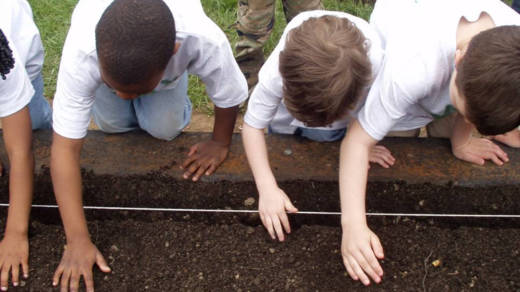Tiny Tom Thumbs and towering Smoke Signals are two of the traditional popcorn varieties our sixth graders harvested from the first planting of a multiyear adventure to breed a new variety of popcorn. We’re documenting our journey as seed savers and using our experience to create public service announcements (PSAs) to invite others to join us as we launch the One Million Seed Savers Campaign in collaboration with the Rocky Mountain Seed Alliance. The students’ goal is to bring awareness to the staggering loss in plant genetic diversity over the last 100 years, and we are working to get 1 million citizens to join us in becoming seed savers.
In the past, my students have done PSAs on soil conservation and on a variety of environmental issues as part of our Earth Care Geek Project. PSAs provide opportunities for students to use persuasive skills and be a voice for social change.
There is a rich selection of possible topics for PSAs: health issues in PE, current events in social studies, and environmental issues in science. Choosing a topic that has relevance to your students will increase buy-in for the project, especially if they know their PSAs will be shared outside the classroom. Partnering with a nonprofit or public agency that can provide expert input on the topic can enrich the experience, and can help get the PSAs to a wider audience, which can energize students’ interest.
Getting Started
- Introduction to PSAs: Review classic examples of PSAs to determine the purpose of the work. And for inspiration!
- Content Knowledge: Discuss the chosen PSA topic and what information would persuade people to make some behavior changes. Craft a strong emotional appeal backed by facts.
- Voice and Choice: Provide a framework for the project by setting clear expectations yet allowing students to express their own interest in the topic. For our One Million Seed Savers PSAs, students have a choice between educating the public on the benefits of seed saving, concerns about the loss of genetic diversity, or the basics of seed saving.
- Authentic Audience: Help students identify their target audience as well as how are they going to reach that audience.
Determining the Guidelines for a PSA
We first review classic PSAs as a class, and generate a list of criteria. Here are some student-generated PSAs guidelines.
- PSAs are for the public benefit.
- They encourage people to change behavior or take action (e.g., get people to wear seat belts).
- They often have a strong emotional appeal (e.g., Native American sheds a tear at the site of all the trash).
- The slogan is memorable such as “A mind is a terrible thing to waste.” Rosie the Riveter and her proud “We Can Do It!” motto is an American icon.
- They are professional pieces that do not have your name on it or “thanks for watching” at the end.
- Most are exactly 30- or 60-seconds long, to fit TV or radio slots.
One of my students’ favorites is this Girl Scouts video about how to make a PSA:
